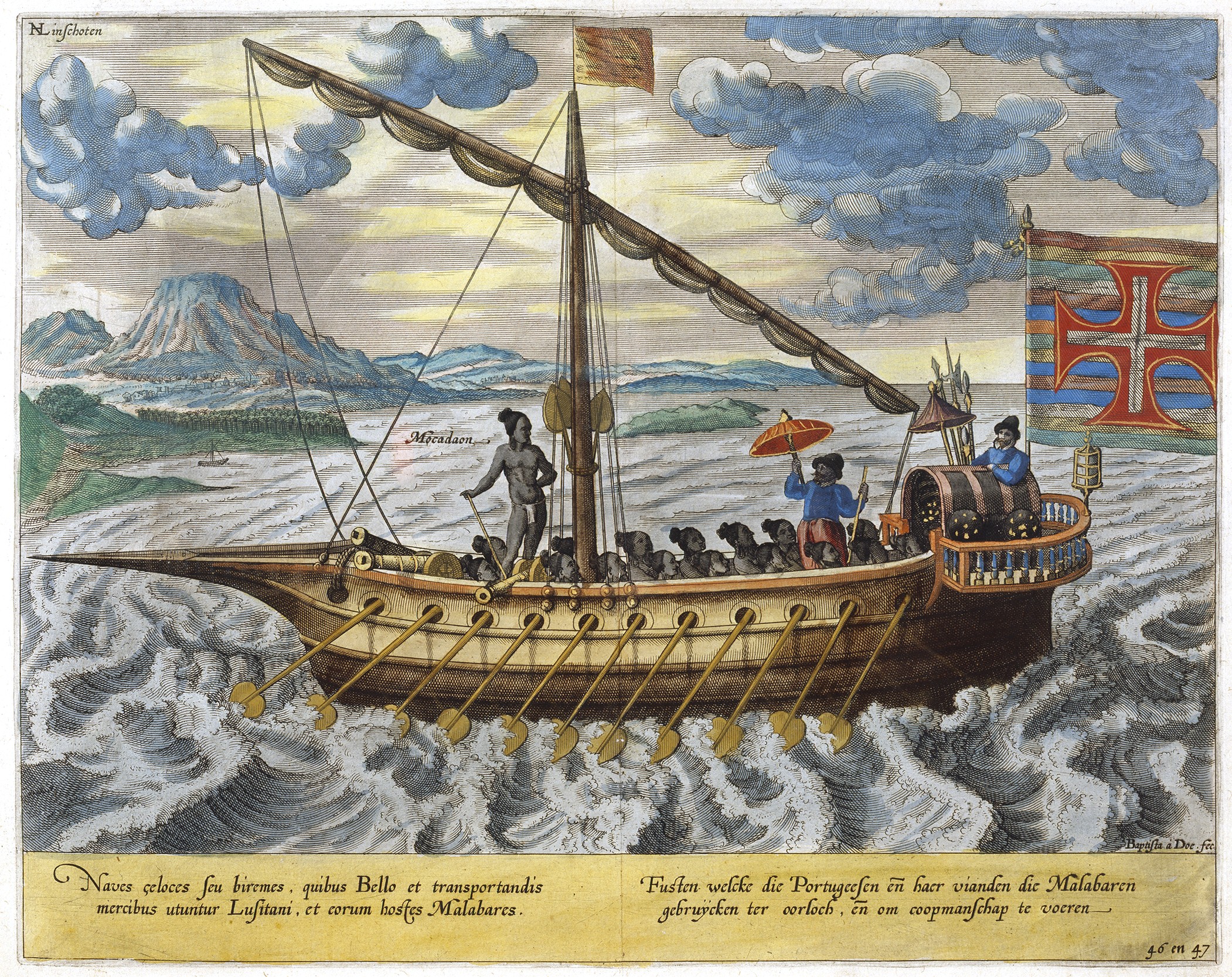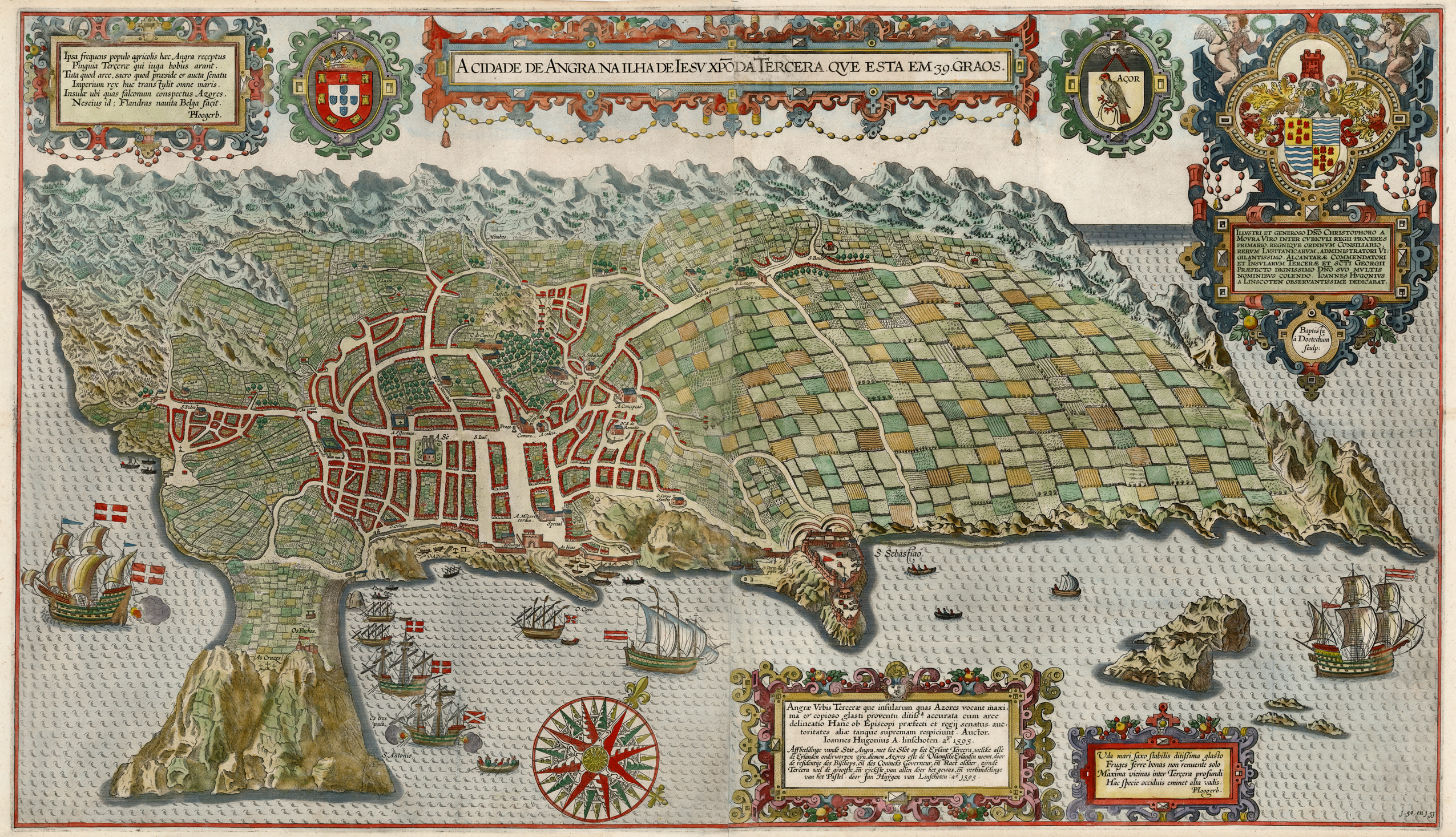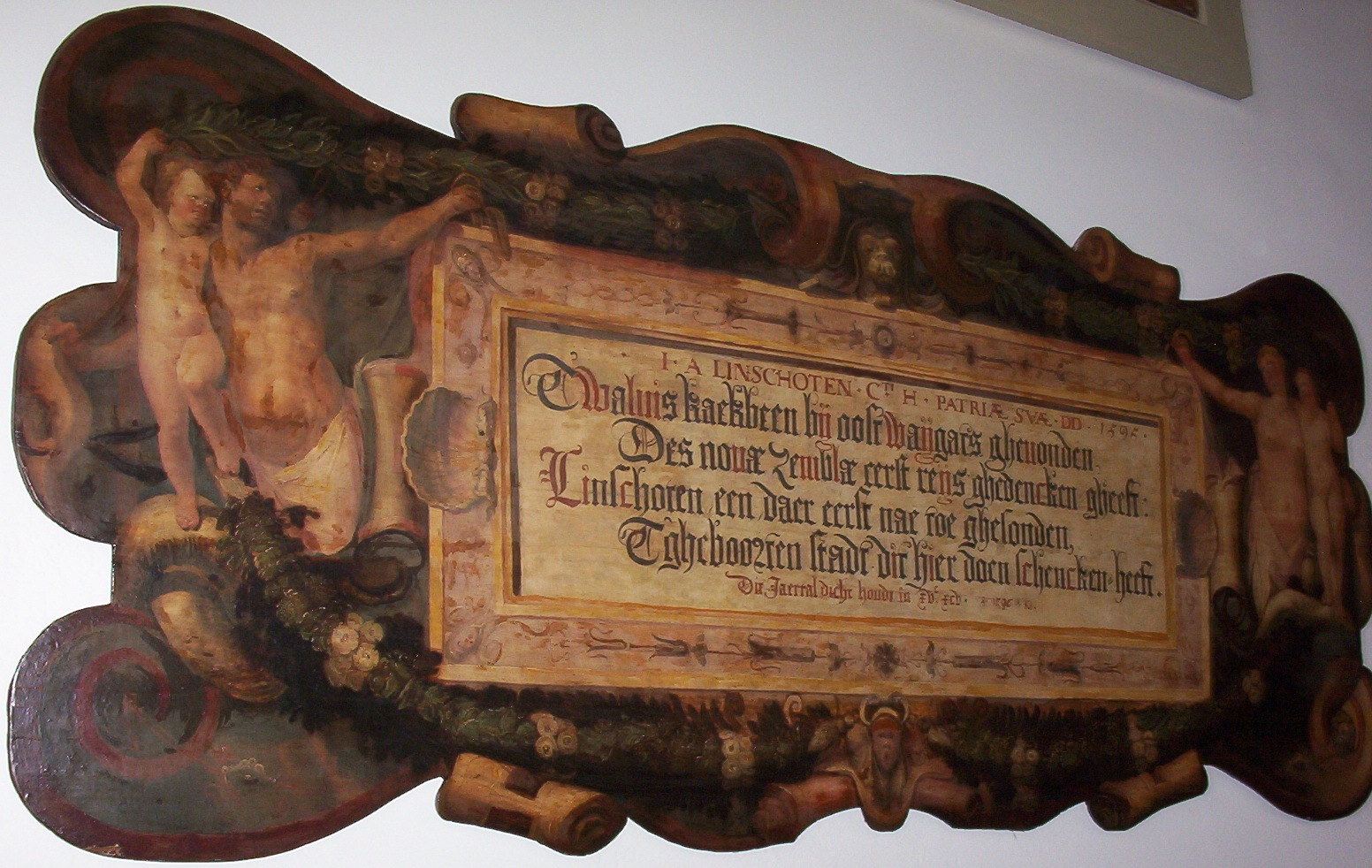1. Early life and background
Jan Huygen van Linschoten's early life was marked by his family's humble beginnings and a burgeoning interest in exploration that would define his later career.
1.1. Birth and family
Jan Huygen van Linschoten was born in 1563 in Haarlem, Holland. His father, Huig Joostenszoon, was an innkeeper and notary, suggesting a family with some civic standing. His mother, Marietje Tin Henrixdochter, had two sons from a previous marriage, Willem and Floris Tin, who were Jan's older half-brothers. Jan also had a younger brother and sister. While he later adopted the patronym "van Linschoten" during his time in Goa, its connection to his family or the village of Linschoten in Utrecht remains unknown. The family relocated to the town of Enkhuizen during Jan's youth, where his father continued his trade as the innkeeper of The Golden Falcon, a business prosperous enough to make loans in the burgeoning shipping industry.
1.2. Education
Details regarding Jan Huygen van Linschoten's formal education are scarce. However, it is believed he attended an Enkhuizen Latin School, where he likely studied reading, writing, mathematics, and some Latin. He later reflected on his passion for "the reading of histories and strange adventures," indicating a strong self-driven interest in the wider world beyond his native Holland. These early inclinations towards discovery and exotic tales profoundly influenced his decision to seek a life of adventure and exploration.
2. Early career and travels
Linschoten's early career began with a desire for adventure and led him through various mercantile pursuits before securing a pivotal role in the Portuguese colony of Goa.
2.1. Initial travels and career beginnings
In 1579, at the age of sixteen, Jan Huygen van Linschoten departed Holland, driven by a youthful yearning for adventure and a desire to accumulate experiences that would provide him with "something to tell [his] children" upon his return. On January 1, 1580, he arrived in Seville, where his two older half-brothers, Willem and Floris, had established a business. He briefly resided with Floris, aiming to learn Spanish and establish himself as a merchant. When Philip II of Spain initiated a military campaign into Portugal in August 1580, Linschoten and his brother Floris followed the army, anticipating new commercial opportunities in the wake of the conquest. Tragically, Floris soon succumbed to a plague epidemic that swept through Spain and Portugal.
Following this personal loss, Linschoten secured employment in Lisbon, working with another merchant. However, a downturn in trade prompted him to seek alternative opportunities. With assistance from his half-brother Willem, who had connections with the newly appointed Archbishop of the Portuguese colony of Goa, the Dominican D. Frei João Vicente da Fonseca, the younger Huyghen was appointed as the Archbishop's Secretary. Linschoten embarked on his voyage to Goa on 8 April 1583, arriving five months later. His journey took him via Madeira, Guinea, the Cape of Good Hope, Madagascar, and Mozambique, exposing him to vast new maritime routes and distant lands.
2.2. Period as Secretary in Goa
From 1583 to 1588, Jan Huygen van Linschoten served as secretary to the Archbishop in Portuguese Goa. During this period, he diligently maintained a detailed diary, recording his observations of the city and its diverse population. He documented the lives and interactions of Europeans, Indians, and other Asians residing in Goa. Crucially, his position granted him unparalleled access to highly sensitive information, including maps and other privileged data concerning Portuguese commerce and navigation throughout Southeast Asia. Leveraging his cartographic and drawing skills, Linschoten meticulously copied and redrew a substantial amount of this nautical and mercantile intelligence, including secret charts that the Portuguese had guarded for over a century. His detailed notes from this time would later form the basis of his groundbreaking publications.


3. Major expeditions and discoveries
Jan Huygen van Linschoten's major expeditions and discoveries were marked by his diligent collection of intelligence in Goa and his participation in voyages seeking new trade routes in the Arctic.
3.1. Gathering information and observations in Goa
During his tenure in Goa, Jan Huygen van Linschoten undertook the critical task of acquiring and preserving highly confidential information about Portuguese trade and navigation. He meticulously copied secret Portuguese navigational charts, page by page, which had been guarded with extreme secrecy for over a century. Beyond mere maps, he compiled vital nautical data, including details on currents, deeps, islands, and sandbanks essential for safe navigation, along with comprehensive coastal depictions. This information was crucial for accurately charting maritime routes.
Upon his return to Enkhuizen, he further augmented his knowledge by collecting accounts from other experienced travelers. Among them was his friend Dirck Gerritsz "China," also an Enkhuizen resident, who earned his nickname from his extensive travels in the Far East. Gerritsz was notably the first Dutchman to journey to China and Japan during three voyages on the Nau do Trato as a constable of artillery. From these diverse sources, Jan Huygen van Linschoten compiled detailed notes on trading conditions among various countries and the intricate sea routes connecting them. This comprehensive intelligence ultimately became instrumental for both the Dutch and the English in their efforts to challenge the established Portuguese monopoly over East Indian trade.
3.2. Return journey and incidents
The death of his patron, the Archbishop of Goa, in 1587 during a voyage to Lisbon to report to the King of Portugal, brought an end to van Linschoten's appointment in the colony. He set sail for Lisbon in January 1589, making a stop at the Portuguese supply depot on Saint Helena Island in May 1589. During this stopover, he met Gerrit van Afhuijsen, an Antwerp resident who had previously been in Malacca, from whom he gained valuable insights into the spice trade in that region.
His journey was then unexpectedly prolonged during a subsequent stopover in the Azores. He was forced to remain there for two years due to a shipwreck, a consequence of the English besieging the island. Utilizing this unexpected downtime, van Linschoten dedicated himself to cartographic work, meticulously mapping the city of Angra on Terceira Island for the island's governor, Juan de Urbina. He finally reached Lisbon in January 1592. After spending six months in the Portuguese capital, he sailed back to his homeland in July 1592, settling once again in his hometown of Enkhuizen.

3.3. Voyages with Willem Barentsz
Upon his return to the Netherlands, Jan Huygen van Linschoten's spirit of exploration led him to participate in attempts to discover the Northeast Passage. In June 1594, he sailed from Texel as part of an expedition led by the notable Dutch cartographer Willem Barentsz. The fleet, comprising three ships, aimed to enter the Kara Sea with the ultimate goal of finding a Northeast Passage above Siberia. During this voyage, the crew encountered a polar bear for the first time at Williams Island. They managed to bring the animal aboard, but it rampaged and had to be killed. Barentsz successfully reached the west coast of Novaya Zemlya and proceeded northward before being compelled to turn back due to massive icebergs blocking their path.
The following year, in 1595, van Linschoten joined a second expedition with Barentsz. This new fleet consisted of six ships, heavily laden with merchant wares intended for trade with China. During this journey, the party encountered Samoyed people, described as "wild men." However, the expedition ultimately had to abandon its goal when they discovered the Kara Sea was completely frozen, rendering further progress impossible. Jan Huygen van Linschoten was one of only two crew members who published detailed journals about these challenging Barentsz expeditions, providing invaluable accounts of Arctic exploration.

4. Writings and influence
Jan Huygen van Linschoten's writings were instrumental in shaping European understanding of the East Indies and directly impacted global trade dynamics.
4.1. Major works and content
In 1595, with the assistance of Amsterdam publisher Cornelis Claesz, who specialized in shipping, geography, and travel literature, Jan Huygen van Linschoten penned his seminal work, Reys-gheschrift vande navigatien der Portugaloysers in OrientenDutch (Travel Accounts of Portuguese Navigation in the Orient). This publication was a compendium of numerous sailing directions, not only for maritime routes between Portugal and its East Indies colonies but also for navigation between India, China, and Japan.
His writings also contain some of the earliest European accounts of tea drinking in Japan. For instance, he noted: "Their manner of eating and drinking is: everie man hath a table alone, without table-clothes or napkins, and eateth with two pieces of wood like the men Chino: they drink wine of Rice, wherewith they drink themselves drunke, and after their meat they use a certain drinke, which is a pot with hote water, which they drink as hot as ever they may indure, whether it be Winter or Summer... The aforesaid warme water is made with the powder of a certaine hearbe called Chaa, which is much esteemed, and is well accounted among them."
In 1597, he published another significant book, Beschryvinghe van de gantsche custe van Guinea, Manicongo, Angola ende tegen over de Cabo de S. Augustijn in Brasilien, de eyghenschappen des gheheelen Oceanische ZeesDutch (Description of the Entire Coast of Guinea, Manicongo, Angola and across to the Cabo de St. Augustus in Brazil, the Characteristics of the Entire Atlantic Ocean).
However, his most famous work is undoubtedly Itinerario: Voyage ofte schipvaert van Jan Huygen van Linschoten naer Oost ofte Portugaels Indien, 1579-1592Dutch (Travel account of the voyage of the sailor Jan Huygen van Linschoten to the Portuguese East India), published in 1596. This work featured a map titled Exacta & accurata delinatio... regionibus China, Cauchinchina, Camboja, sive Champa, Syao, Malacca, Arracan & PeguLatin, which was prepared by Petrus Plancius.
The Itinerario quickly gained international recognition. An English-language edition, titled Iohn Huighen van Linschoten his Discours of Voyages into ye Easte & West Indies, was published in London in 1598. The same year saw a German edition. Its significance was further underscored by its publication in Latin in Frankfurt in 1599, another Latin translation in Amsterdam in 1599, and a French version in 1610. The Itinerario continued to be re-edited and republished until the mid-17th century, long after van Linschoten's death.
Beyond his direct travelogues, Jan Huygen van Linschoten also contributed to the intellectual discourse of his time through translations and other publications. In 1597, he published the Dutch translation of Father José de Acosta's book on Spanish America. In 1601, he released an academic account of his own northern travels. His final known publication in 1609 was a Dutch translation of a letter from the Duke of Lerma, Philip III of Spain's favorite, concerning the Moorish revolt in Spain.
4.2. Impact on European trade and exploration
Jan Huygen van Linschoten's publications had a profound and transformative impact on European trade and exploration, directly challenging and ultimately dismantling the century-long Portuguese monopoly on the lucrative East Indies trade. His Itinerario was revolutionary because it graphically displayed, for the first time in Europe, detailed maps of voyages to the East Indies, particularly India. More critically, he divulged comprehensive nautical data, including information on currents, deeps, islands, and sandbanks vital for safe navigation, alongside precise coastal depictions. The revelation of these previously secret Portuguese navigational routes effectively "opened the passage" to the East Indies for other European powers, including the Dutch, French, and English.
As a direct consequence of his work, the 16th-century monopoly enjoyed by the Portuguese on trade with the East Indies was broken. This pivotal shift enabled the establishment of powerful trading entities such as the Dutch East India Company (VOC) and the British East India Company (EIC), which would come to dominate Asian commerce.
Van Linschoten not only provided the crucial "geographic key" to unlock the Portuguese grip on the strategic Malacca Strait but also offered a vital alternative. He advised traders to approach the East Indies from south of Sumatra through the Sunda Strait, thereby significantly minimizing the risk of Portuguese intervention. This alternative passage subsequently became the primary Dutch route into Southeast Asia and was the foundational origin of their colonization of the territories that comprise modern-day Indonesia.
His meticulously collected data was extensively utilized in the preparation of the first Dutch fleet to Asia, led by Cornelis de Houtman from 1595 to 1597. Van Linschoten provided the specific route that de Houtman followed, sailing to the west of Madagascar on the way to Java island, a route that the Dutch would continue to use for many years thereafter. He actively participated in the strategic debates surrounding the fleet's preparation and its ultimate destination. His critical contributions led to direct polemics during his lifetime with Petrus Plancius, who later became a cartographer for the VOC, regarding the preparations for de Houtman's fleet and Linschoten's own northern sailings. He also collaborated closely with other prominent cartographers and scholars, such as Lucas Janszoon Waghenaer and Bernardus Paludanus, further solidifying his influence in maritime knowledge and exploration.
5. Later life and contributions
After his pivotal contributions to breaking the Portuguese monopoly, Jan Huygen van Linschoten continued to be an influential figure in his community and in Dutch maritime endeavors.
5.1. Personal life and civic duties
In 1595, Jan Huygen van Linschoten married Reynu Meynertsdr. Seymens in Enkhuizen. At the time of their courtship, Reynu Seymens was thirty-one years old and already a mother of three. She was also four months pregnant with their child, a circumstance that may have hastened their marriage given van Linschoten's extensive voyaging career. From 1597 until his death, van Linschoten served as the Treasurer of his hometown, Enkhuizen, a significant civic role that highlights his established position and trust within the community.
5.2. Role in Dutch expansion and collaboration
Jan Huygen van Linschoten's expertise remained highly valued in the nascent stages of Dutch maritime expansion. In 1606, he formally joined the newly established Dutch East India Company (VOC), further cementing his direct involvement in the burgeoning trade empire he had helped to enable. His counsel was sought even regarding the establishment of the Dutch West India Company (GWC) in 1609, indicating his continued influence on broader Dutch colonial ambitions.
He played a direct role in preparing Cornelis de Houtman's first fleet to Asia (1595-1597), providing crucial route information, including the path sailing west of Madagascar to Java, which became a standard Dutch route. His engagement in these strategic preparations also led him to participate in debates with Petrus Plancius, who would later become a prominent cartographer for the VOC, concerning both de Houtman's fleet and Linschoten's own expeditions to the North. Furthermore, his collaborative efforts extended to working closely with other influential cartographers and scholars of the era, including Lucas Janszoon Waghenaer and Bernardus Paludanus, contributing to a collective body of knowledge that advanced Dutch navigation and exploration.
6. Death
Jan Huygen van Linschoten died in his hometown of Enkhuizen on 8 February 1611, at the age of 48. He had served as the town's Treasurer since 1597, maintaining a prominent civic role until his passing.
7. Legacy and honors
Jan Huygen van Linschoten's historical legacy is profound, primarily stemming from his pivotal role in opening up the East Indies to European powers beyond Portugal. His detailed publications democratized crucial navigational and commercial information, directly fueling the rise of Dutch and English maritime empires.
In recognition of his contributions to the documentation of Dutch travel and exploration, the Linschoten Society (Linschoten-Vereniging) was founded in the Netherlands in 1908. This society is dedicated to publishing rare or previously unpublished Dutch accounts of voyages, land journeys, and descriptions of countries, preserving the tradition that van Linschoten exemplified. Further acknowledging his global impact, the minor planet 10651 van Linschoten was named in his honor, a testament to his lasting place in the history of exploration and cartography.